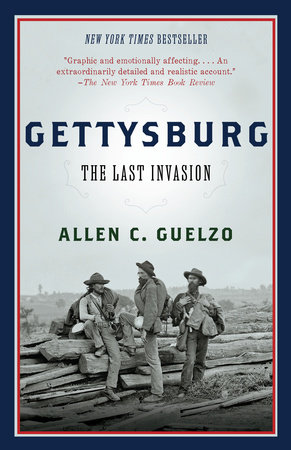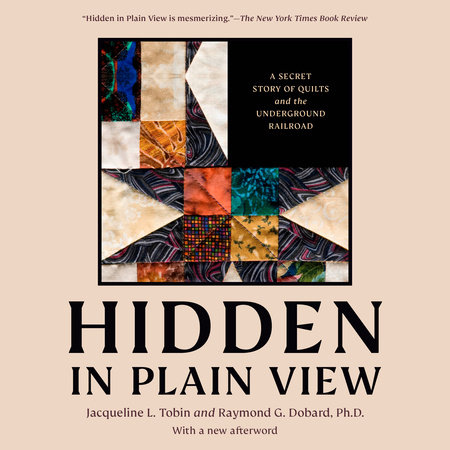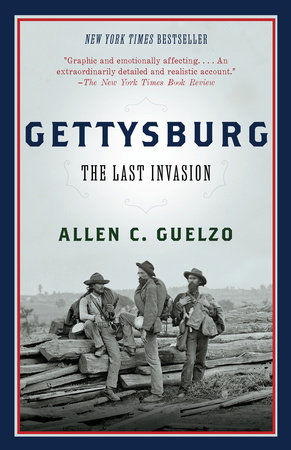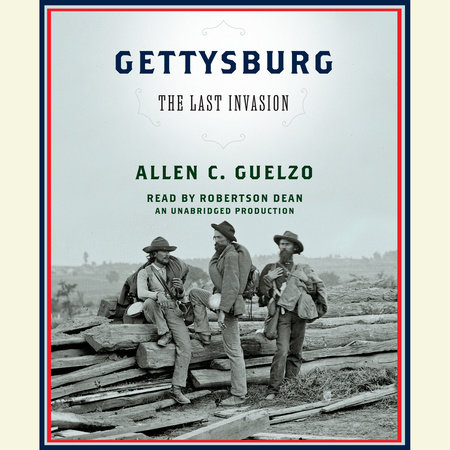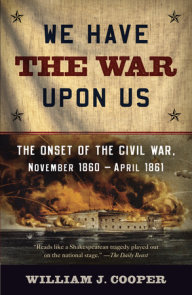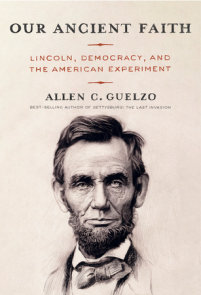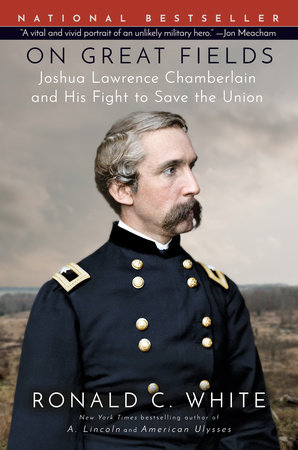Author Q&A
A conversation with Allen C. Guelzo
author of GETTYSBURG: The Last Invasion
Q: In the last 150 years, there have been many books written about the Battle of Gettysburg. What sets yours apart?
A: Politics. The American Civil War was, at bottom, a political war, so we shouldn’t be surprised, then, to find that politics slopped-over into military decision-making at Gettysburg. In the Union army, anti-Lincoln Democratic generals were as hostile to anti-slavery Republicans as they were to the rebels. In the case of George Gordon Meade, commanding the Union army at Gettysburg, politically-motivated decisions nearly cost him the battle.
Q: As we approach its 150 year anniversary, what do we still have to learn about the Battle of Gettysburg? What myths about the battle do you debunk?
A: So much was at stake at Gettysburg that it’s no wonder so many myths were born out of the fighting. These myths serve mostly as a way of trying to reduce the battle’s chaos to something like rationality. But myths are still only myths.
The most prominent of these is that Robert E. Lee’s cavalry commander, J.E.B. Stuart, foolishly galloped his cavalry on a long detour around the Union army, and his extended absence deprived Lee of intelligence about the movements of the Union army. Actually, intelligence-gathering was not the job of cavalry; in fact, cavalry in both armies performed a comparatively insignificant role in the War as a whole. The ratio of cavalry to infantry in the American Civil War was less than half that of European armies, and it was almost entirely light cavalry, and so could perform only screening and raiding.
Another myth is that Little Round Top was the most critical feature on the Gettysburg landscape, and that the battle was saved for the Union by the heroic performance of one Union regiment there, the 20th Maine, under Joshua Lawrence Chamberlain. Actually, the most important piece of military real estate was Cemetery Hill. It was the finest artillery platform in south-central Pennsylvania. The fight for Little Round Top happened by impulse, and while it was done bravely and well, Chamberlain’s stand was only one of at least half-a-dozen brilliantly spontaneous decisions by mid-level commanders that day.
Maybe the most egregious legend is the one which says that the battle happened accidentally, that the two armies blundered into each other. Actually, Robert E. Lee had predicted a battle near Gettysburg, and was concentrating his army there when the fighting broke out.
Q: Your book describes the soldiers’ experience in more detail than has ever been done before. You even reference a schoolgirl essay competition in 1860! How did you go about your research? What did you discover that most surprised you?
A: It was as much what I was looking for as it was what I was looking in. I spent several years doing little more than soaking myself intensively in printed and manuscript sources on the battle, and walking over one part of the battlefield after another (and believe me, it certainly helps to live next to it). That research took me to manuscript collections from the University of Virginia to Harvard, led to correspondence with historical societies and collections from Ohio to North Carolina to Maine to Georgia, and even to several late-night bar-stops with the reclusive national guru of Civil War battlefield photography. What I was looking for, however, was the texture of experience—the record of what the battle felt like, smelled like, sounded like, looked-like—and the recreation of the mental geography (the expectations, in other words) of those who fought in it.
Certainly the most surprising discovery for me concerned George Gordon Meade. I began this project originally believing that Meade had been vastly and unfairly misunderstood by Lincoln. But as I began reading the Meade family papers at the Historical Society of Pennsylvania, an entirely different George Meade emerged for me—a temperamental, politically partisan, and highly insecure individual who mostly avoided losing the battle rather than actually winning it.
Q: What was the experience of townspeople during the battle? How long did it take to recover?
A: A large portion of the townspeople weren’t even there. The most prominent—town office-holders, the local postmaster, bank clerks, the telegraph operator—all beat it eastwards, fearing they would be taken hostage. So did the most vulnerable—Gettysburg’s black population, which feared they would be kidnapped and re-enslaved. (They were right: approximately 500 free black residents of south central Pennsylvania were herded together and marched off to the slave markets in Richmond). Those who stayed to protect their property spent most of the battle huddling in their cellars, like college professor Martin Stoever, who smoked twenty-one cigars in a row while the fighting on the battle’s first day raged overhead.
The town did not take long to recover, however. The principal merchant in Gettysburg, George Arnold, was advertising new goods for sale within a week of the battle. In fact, Gettysburg would go on to a new apex of agricultural and business prosperity in the 1880s. But there are some senses in which the town has never recovered from the battle to this day, starting with the pockmarks and bullet-holes still visible in buildings around Gettysburg. We call the student delicatessen at the College the “Bullet-Hole.”
Q: Who were the main players and how were their personalities influential? How did politics shape the outcome of the battle?
A: Clearly, they were the two commanding generals, George Gordon Meade and Robert E. Lee. Although Lee cultivated the image of a lofty patrician cavalier, he was really a relentlessly aggressive driver who was convinced that the Gettysburg campaign would be the knock-out blow that finished-off North’s will to fight. He was not alone in thinking that way: Jefferson Davis, the president of the Confederacy, had his vice-president, Alec Stephens, on board a pilot-boat in the James River, ready to journey to Washington and hold talks with Lincoln if the results of the campaign were favorable. Even the ordinary soldiers of Lee’s army were jubilant at what they saw as the opportunity to finish the war at Gettysburg.
Meade, by contrast, was notoriously temperamental, but also fussy, precise and cautious. Not that he lacked reason. Meade was appointed to command only three days before the battle, with barely time enough to discover where the parts of the army were located. He also was painfully aware that his predecessors in command—George McClellan, Ambrose Burnside, and Joe Hooker—had been put up one-by-one and knocked down one-by-one, with little backing-up from the Lincoln administration.
In the end, Lee’s aggressiveness tipped-over into recklessness. But Meade’s self-righteous caution prevented him from gaining the all-or-nothing victory that was within his grasp.
Q: You write, “few people understood that the principal figure in making the Gettysburg battle happen in the way it did was a man who wasn’t even there for most of the three days, and that was John Reynolds.” Who was John Reynolds and what key role did he play?
A: John Reynolds was a West Pointer and an artillery officer before the war, and had once been commandant of cadets at West Point. He had a reputation as a quiet, somewhat detached, but very competent combat officer, and by 1863, had risen to command the 1st Corps of the Union Army of the Potomac. He and Meade had a friendly but distant relationship, and in fact Reynolds had been offered command of the Army of the Potomac before it went to Meade.
As a Pennsylvanian—and a native of south-central Pennsylvania—Reynolds was anxious that Meade’s preoccupation with shielding Baltimore and Washington meant that Meade would allow the Confederates to rampage through Pennsylvania without serious hindrance. While Meade wanted to fight a defensive battle behind Pipe Creek in Maryland, Reynolds was eager to get to grips with the Confederates in Pennsylvania. In large measure, Reynolds bolted ahead of Meade and forced the reluctant army commander into fighting at Gettysburg instead. This amounted to a quiet sort of insubordination on Reynolds’ part, but Reynolds was killed just after the battle began, so there was never any question afterward about disputing his judgment.
Q: How did the outcomes of European wars influence the decisions of the Civil War generals? How did the opposing armies in the Battle of Gettysburg differ from all armies before them?
A: We tend to read the Civil War as a uniquely and exceptionally American event. It wasn’t, and Gettysburg was fought by soldiers who had lived through and observed the Crimean War (1854-56) and the North Italian War (1859) and were contemporaries of the Austrian, Prussian and French wars of the 1860s. These European conflicts shed an enormous amount of light on the behavior of soldiers and commanders on both sides at Gettysburg. Pickett’s Charge, for instance, doesn’t make much sense until you line it up beside events like the successful frontal attack of the British at the Battle of the Alma in the Crimean War, or the French attack at Solferino in 1859; after that, it seems perfectly reasonable.
Q: The Union victory at Gettysburg occurred virtually simultaneously with the Union victory at Vicksburg. Was one more significant in determining the outcome of the war?
A: Yes and no. Vicksburg eliminated the Confederacy’s grip on the Mississippi River valley, which had blocked the North’s principal commercial highway. But the consequences of Vicksburg were more political and economic than military. Much of the opposition to the Lincoln administration had come from mid-western states which were hurting because of the Mississippi River blockage. The fall of Vicksburg took the steam out of a lot of that opposition. But it did not automatically change the military situation. The real line of operations, from a military point-of-view, ran along the line from Tennessee through Chattanooga into Georgia and Atlanta, and it would take the Union army another year-and-a-half to force that line open.
Gettysburg had more immediate military significance, because it demonstrated that the Confederate army was not irresistible, and that Robert E. Lee could be defeated. But that significance was limited by George Gordon Meade’s failure to follow-up and completely destroy Lee’s army. Lee would fight on for almost two more years. On the other hand, both Vicksburg and Gettysburg replenished Northern morale. They made July 4, 1863, the best Independence Day since, well, independence, and the best weekend the North had had in the war.
Q: Should Meade have pursued the Confederates after the battle? Had he done so, would that have ended the war any sooner?
A: Abraham Lincoln certainly thought so, and Meade’s failure to bag the Confederate army afterwards was so bitter a disappointment that it’s one of the few moments on record when Lincoln (who was not a sentimental man) actually broke down and cried. It’s true that Meade’s army had been pretty badly battered by its victory, and that any hot pursuit of Lee involved some very real risks. But Lee’s army had been damaged much more greatly. Ironically, only six months or so before, Meade had turned on his former sponsor, George McClellan, for not taking risks. “I am tired of playing this war without risks,” Meade said then, “Such a general will never command success, though he may avoid disaster.” Those words rise up in judgment on Meade, because that’s exactly how he ended-up behaving at Gettysburg and after. The result was that the Confederates escaped, and the Civil War dragged on for nearly two more bloody, carnage-ridden years.
Q: The Battle of Gettysburg had the greatest number of casualties in the American Civil War (Lee reported 20,451 casualties in all; Meade reported 24,000 men killed, wounded and missing. What was the cause of such mass casualties?
A: Like all Civil War battles, this was largely because the armies which fought at Gettysburg were volunteer armies, not long-service military professional armies or trained reserves like those we might find in Europe. The ordinary soldiers of the Civil War were poorly trained, poorly disciplined, and poorly led; even when they had West Point-trained commanders, the West Point training was an education in engineering, with almost no attention to combat tactics. The unendurably-long casualty lists flowed from amateur soldiers whose best idea of combat was simply to blaze away at short distances in motionless fire-fights. The great Prussian general Helmut von Moltke was supposed to have said that the American Civil War was really just two armed mobs, chasing each other around the countryside. Moltke actually had a far more serious interest in the Civil War than that comment suggests; but even if he didn’t say it, there is a nugget of truth in it all the same. Plenty of heroism, but not much professionalism. Which, unfortunately, is also how most American wars have been fought.
Q: You write about how the significance of rifling technology has been overrated by military historians, whereas the bayonet has been underrated. Why is that?
A: The rifle musket had actually been in combat use since the late 18th-century, and even more so from the 1840s in the new ‘system’ invented by Claude-Étienne Minié. It was much less a revolutionary surprise to the Civil War experience than we often think. But even more, while the Minié rifle (and its various imitations, the American Springfield rifle musket, the British Enfield rifle musket, and the Austrian Lorenz) improved the range and accuracy of the musket, it did not improve it by that much. The rifling which imparted the increased accuracy to the musket also made it more finicky to use in practice; and since the rifle musket was still a single-shot, muzzle-loading black-powder weapon, it kicked out clouds of powder-smoke which, in a very short while, created cloud-banks of powder-fog that removed any of the benefits from longer range. It doesn’t matter how accurate your weapon is, if you still can’t see the enemy through the smoke. For this reason, most fire combat in the Civil War takes place in parade-ground line formations, only eighty to one hundred and twenty yards apart, just as it had in George Washington’s day.
The weapon that was supposed to dominate the battlefield was the bayonet. Fire combat served either to soften up a defender or suppress an attacker; either way, it was only the prelude to closing with the bayonet. But that required a level of training which the Civil War armies never received. Hence, the tendency for battlefields like Gettysburg to bog down in slow-moving slugging matches, piling up corpses until one side or the other gives way.
Q: How did the circumstances of this battle affect its outcome? How was the land itself so crucial to how the battle played out?
A: Geography made the battle. For anyone moving along the great Lancaster Pike, Gettysburg is the first major crossroads of east-west and north-south highways. Its location sucked the two armies into collision. Once begun, the battle was really a series of fights along Gettysburg’s north-south ridge-lines—McPherson’s ridge, Seminary ridge, Cemetery ridge—which gave most of the advantages to the defending Union forces.
Q: What commonalities do you see between the Battle of Gettysburg and the way war is waged today?
A: Not many. The First World War was the moment where modern warfare broke completely and decisively from the past, due mainly to the advances in weapons technology before 1914. Sending soldiers in long lines to the attack had to give way to small-group infiltration tactics; artillery rather than rifles and bayonets became the chief source of casualties; the balance between the numbers of soldiers in combat and the number in rear-echelon support roles shifted drastically. The Civil War was still fought by soldiers, fighting shoulder-to-shoulder in long lines with short-range weapons; artillery in the Civil War mostly served to disrupt attacking formations and inflicted a much smaller percentage of casualties; and the Civil War ratio of combat to non-combat personnel was approximately 10-to-1. The Civil War faced backwards, to the wars of Napoleon and the 18th century, far more than it did to the future. You could not fight a modern war in the way the battle of Gettysburg was fought.
Q: You have lived in Gettysburg for the last ten years. How did your familiarity with the land influence your writing?
A: It gives a very keen feel for what the soldiers could see, and what the commanders could know. It’s only when you stand on Cemetery Hill that you realize what a marvelous position it was for artillery. Most of the topography in south-central Pennsylvania is a series of undulating ridges, running from the outliers of the Appalachians to the Susquehanna River. But Cemetery Hill is a broad flat plateau, with gorgeous sight-lines for miles all around, and at just the elevation most desired by 19th-century artillery. But you’d never guess that merely from scanning a map.
The other gift given by living here is a familiarity with the look of the place. Except for the annihilation of the chestnut tree in the 20th century, the landscape is still dotted by most of the same species that the soldiers encountered in the battle. So, when soldiers in the 17th Maine talked about fighting at the edge of an alder thicket, you can find those alders still growing there today. And that lets me fill in the color palette of description in ways you couldn’t do if you were only an occasional visitor here. I’m a big fan of James Lee Burke’s mystery novels, and one thing I particularly love is the almost-touchable sense of the persimmon, cypress and pecan trees, the bayous, the sunlight of southwestern Louisiana. I’ve tried to do impart some of that same sense to the Gettysburg terrain.
FOR BOOKING INFORMATION:
Erica Hinsley / ehinsley@randomhouse.com / 212-572-2018
Erinn McGrath / emcgrath@randomhouse.com / 212-572-2035
